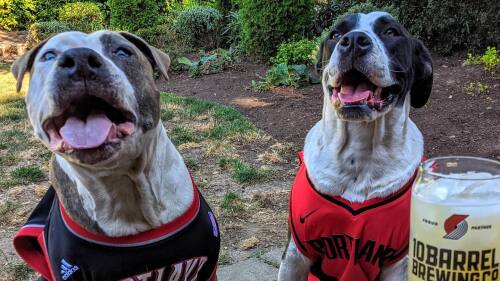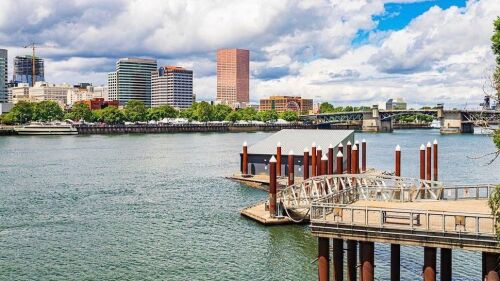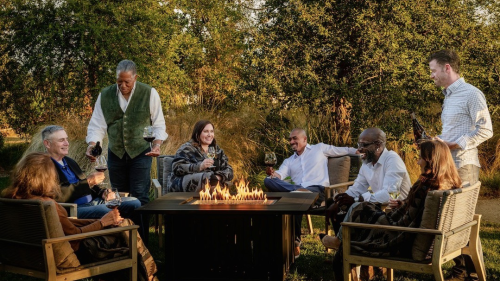This piece is part of our PDXtoday Q+A series. Do you know someone we should interview? Nominate them here.
The Forest Park Conservancy is working to protect the ecological health of Portland’s beloved Forest Park. It received a conservation easement donation of 60 acres near Forest Park this year that will help safeguard the park’s long-term health.
We recently chatted with Alejandro Orizola, the conservancy’s conservation director, to learn more about the organization and the donation.
Q: How long has the Forest Park Conservancy been active?
A: So the conservancy is an organization that really traces its origin back to around the time when Forest Park was dedicated as a city park in 1948. But it has changed its name and its composition. It started as a group of concerned citizens that were advocating to protect the park. It then turned into something more formal that was called Friends of Forest Park, which was mostly focused on more fundraising and supporting the city’s efforts to acquire land for the work inside the park. For about 15 years now, we moved into the conservancy model, which basically means we play a more active role in the management of the park. So we are directly partnering with the City of Portland and taking on some of the management duties inside the park. Specifically, we do work in 47 miles out of the 70 miles of the trails network inside the park. We also support the city’s efforts in controlling invasive species. We do this all by basically engaging with the community and having volunteers come help inside the park through our volunteer events and other programs.
Q: Have you ever hiked every trail mile in the park yourself?
A: No, I would love to say that I do, but I haven’t. The reality with my position is that I don’t get to work that much in the park. That said, there’s multiple folks within the organization that are lucky enough to have done that — actually, one of our development directors ... she holds the record of like, competing Wildwood Trail in the shortest time in one attempt, which is like 30-something miles.
Q: Why does the conservancy also focus on areas outside of Forest Park?
A: Forest Park, even though it’s big — and it’s the biggest park in the city, it’s 5,200 acres — is part of a larger landscape. So it’s not an island, but part of this larger eco region. So by protecting this larger eco region, we’ll be protecting Forest Park. You know, invasive species do not know about boundaries between properties or city properties or private programs.
Q: Let’s talk about the recent land donation. Can you give us a brief overview of where it’s located?
A: So when we receive a donation — not a piece of land, but a conservation easement on our property — it’s a conservation easement on a 60-acre parcel that is located north of Forest Park off Cornelius Pass Road. So this is not adjacent to Forest Park, but it’s in this general area that I was talking to you about it. This is an effort within that framework of a large landscape conservation effort, we are looking at how can we protect this eco region which in particular, it’s in mountains and it’s located in a very unique position because it actually connects the Oregon Coast Range with the Willamette Valley and the Columbia River Gorge. So there’s a high value in terms of connectivity for wildlife.
Q: What exactly is a conservation easement?
A: Basically, a conservation easement is a legal agreement between the landowner of a property and a third party. This agreement basically establishes certain restrictions on the uses of a property in order to advance or protect certain conservation values within the property while keeping the land in the owners’ ownership and control.
Here’s an example: You, Cambrie, own a 10-acre parcel somewhere that has high value for conservation purposes and you grant a conservation easement to a third party which would be for example, Forest Park Conservancy. That easement would probably say “Cambrie is the owner of this property, but by the terms of this easement, she will not be able to build more than 10 houses, or clear cut the property, or fill in wetlands.” And those restrictions are recorded in the property titles in the benefit of this third party which is Forest Park Conservancy, which basically assumes your allegation of monitoring and enforcing the terms of use. What we are basically doing is not only protecting Forest Park, but we’re protecting properties around Forest Park by taking on this easement and assuming the obligation to monitor the terms of the easement and enforce them if necessary.
In particular, this property was donated by Diane Field and Richard Williams, who are a couple who’s been doing conservation work for a number of years in this property. They’ve been working very closely at least for the last 10 years with the West Multnomah Soil & Water Conservation District to implement restoration practices within the property to basically promote forest health and secure some of these ecological features of the property.
Q: Why is this donation important?
A: This donation is really important and comes at a critical time in which we’re seeing, number one, increased development pressure for land around Forest Park — this is just a result of the housing market in Portland — but also increased interests in some landowners in finding places to live not in town.
It also is really important because it’s the one construction that kickstarts larger land conservation programs within the organization, which we’re devoting time, resources, and staff in identifying those properties that we think are ecologically relevant and strategic to achieve this larger goal of protecting the ecological corridor.
And third, because it comes within the framework of this larger collaborative effort. So even though it’s something that Forest Park Conservancy is doing itself with support from West Multnomah Soil & Water Conservation District, the impact of protecting this land will have an expansive effect and benefit multiple stakeholders in the area.
Q: Can you talk about potential future properties that might also become conservation easements in the area?
A: Unfortunately, I cannot talk about specific properties, we have some ongoing conversations and have identified a couple, but I cannot share them. I can say this, though — we are very actively looking into this larger landscape and area surrounding Forest Park and we have basically set ourselves up to be successful and continue adding more of these conservation easements to the structure map.
My hope is that in five years’ time, I can show you a map and say, This is where we were and this is where we are, and see how basically, we’re putting together a puzzle of how we connect properties and properties that are protected, that connect private land with Forest Park with some of the Metro holdings, some of their natural areas, etcetera, all the way to the Oregon Coast Range.
Q: What would you like people to know about conservation at Forest Park?
A: [The donation is] one component of a much larger directive of how we think about Forest Park and natural areas and public natural areas, and how by protecting a larger piece of land, we’re also trying to address issues of access to the outdoors, to address climate change, by generating climate change resiliency, and also trying to better understand how we serve the community.
Forest Park, as you might be aware, it’s just so unique in terms of its locations and size, that it’s kind of like its own beast, in a way that presents multiple challenges. But at the same time, it’s one of those rare cases of natural areas, where it’s so closely connected with the community that’s around it, that it’s important for us to reinforce the idea that this is not conservation that’s for conservation, this is really conservation for the people.
Q: How can people get involved and help?
A: Well, the easiest way to get involved is to visit our website and different social media channels. We’re constantly posting opportunities to volunteer in the park, information about the different programs that we have. We don’t only have these one-off events, but we also are providing opportunities for volunteers to engage in more permanent and long-term capacities so they can become rapid responders, which is basically a group of volunteers that are committed to taking care of certain sections of trails in the park and report if there are fallen trees, or landslides or whatever. Then we also have a Forest Park Ambassador Program, which is really having people out there in the park and like sharing our mission, our goals, and our programs, but also supporting and helping the users of the park and providing information about responsible recreation, trailheads, safety guidelines, etc.











